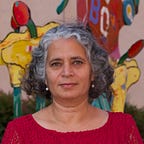Navratri Memories
Happy Ashtami to all who celebrate.
Growing up in Delhi, this was the festival we kids, especially girls, waited for. We were invited to several homes of our (Punjabi) neighbours, for a festive breakfast that marked the eighth day of ending a fasting period for them. The menu was always the same with minor variations, poori, kala chana, halwa and always a token amount of cash (a 50 paise coin was the norm, although it could vary from 10p to a rupee). There were so many invitations that there was no way to eat all the food on offer, so it was understood that we would come for the rituals, bring a plate from our home, transfer the offered food to it, and leave with it. Rushing to deposit the food back at my home, grabbing another plate and off to another home to repeat the rituals again, all with the same lot of girl friends in the neighbourhood.
The ritual typically involved the host welcoming me by washing my feet at the entrance to their home, before inviting me to sit down on the floor in their living room, prepared with white sheets or mats, with a small altar setup for their weeklong fast. A red-yellow moli ceremonial thread being tied on my right wrist, or left on the plate with the food, a red tikka marked on the forehead with vermillion, and then the offering of the food, enough to feed the family. Typically there would be seven girls, give or take a couple, depending on who they could invite. Then we were free to take the food and go. If we forgot to bring our plate to take home, we could take theirs and bring it back later in the day. Going to half a dozen houses for this was normal, all between 9–11am, with neighbours coordinating to make sure we knew whose house we went to next in the rounds.
As we rushed between collecting and depositing food — if my friends went to different neighbours than me, we would stop just long enough to compare notes on how much ‘free’ money we had accumulated from whom. These token amounts of loose change seemed to us to be a huge fortune, as the candy store at the end of the street sold sweets that started at 5paisa each. The same food tasted different as each family has their own unique recipes. Apart from the yummy and rich food, my lasting memory is of my friend’s dad washing my feet, an uncommon act of reverence that can’t be explained in words.
During the days of fasting, leading up to this, my friend Neeru’s would visit the Jhandewalan temple everyday, like many other devotees. The long narrow path leading from the main road to the temple was converted into a festive market. The usual parsad and flower sellers, were joined by make shift shops or footpath stalls selling trinkets and toys, red duppattas with gold kinari and gota and always glass bangles, lots of them. The red and gold duppattas were offered to the goddess and then given to the girls to use. They added a festive spirit with the requisite bling. We would accompany her to the temple atleast once, braving the crowds, at the risk of getting lost, just to get our supply of glass bangles. We chose the colours and styles we fancied, with a lot of fuss and consultation with each other. The jingle jangle of these breakable delicate jewels was the other highlight of the Navratras, the nine-nights, as the festive period is called.
